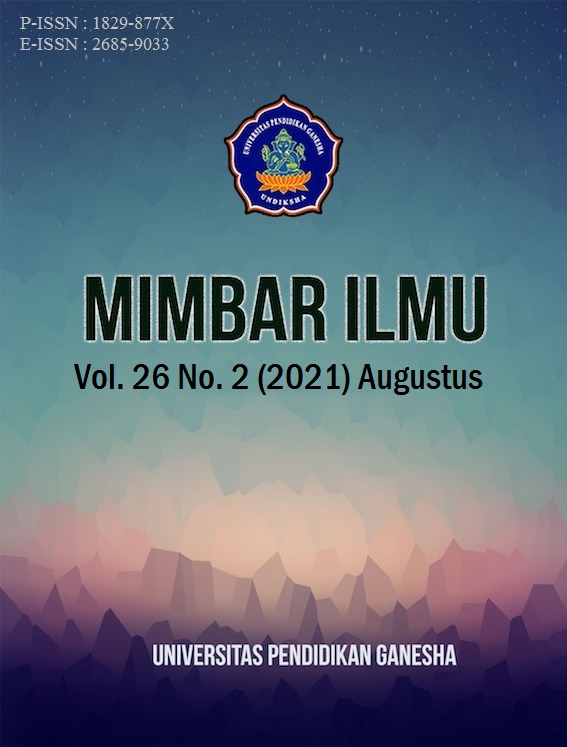Pendidikan Responsif Gender dan Kesehatan Reproduksi dalam Proses Pembelajaran
DOI:
https://doi.org/10.23887/mi.v26i2.38505Keywords:
Pendidikan Responsif Gender, Kesehatan ReproduksiAbstract
Kondisi di sekolah pada umumnya menunjukkan masih adanya ketimpangan peran gender dalam proses pembelajaran. Ketimpangan tersebut muncul pada berbagai aspek, antara lain adalah ketersediaan sarana sekolah yang kurang memperhatikan kebutuhan berimbang antara siswa laki-laki dan perempuan, sikap bias gender guru terhadap siswa, materi ajar yang tidak responsif, dan lingkungan belajar yang belum responsif. Penelitian ini bertujuan untuk menganalisis pendidikan responsif gender dan kesehatan reproduksi dalam proses pembelajaran. Penelitian ini menggunakan metode deskriptif kualitatif. Subjek penelitian adalah kepala sekolah dan 7 guru. Teknik pengumpulan data dilakukan melalui wawancara, observasi, dan dokumentasi. Teknik analisis data dilakukan dengan cara mereduksi data, menyajikan data, dan menarik kesimpulan. Hasil penelitian menunjukkan bahwa pendidikan responsif gender dan kesehatan reproduksi yang diimplementasikan melalui merancang pelaksanaan pembelajaran yang responsive, mengintegrasikan pesan gender dan kesehatan reproduksi pada mata pelajaran, dan merancang hidden kurikulum efektif untuk memberikan pemahaman gender dan kesehatan reproduksi bagi siswa di sekolah dasar.
References
Abraha, M., Dagnew, A., & Seifu, A. (2019). Gender Responsive Pedagogy: Practices, Challenges & opportunities- A Case of Secondary Schools of North Wollo Zone, Ethiopia. Journal of Education, Society and Behavioral Science, 30(3), 1–17. https://doi.org/10.9734/jesbs/2019/v30i330128.
Barreiro-Gen, M., Lozano, R., Temel, M., & Carpenter, A. (2021). Gender equality for sustainability in ports: Developing a framework. Marine Policy, 131, 104593. https://doi.org/10.1016/j.marpol.2021.104593.
Dary, A. W., & Ilyas, F. (2019). Pengaruh Gender, Penghargaan Finansial Dan Pertimbangan Pasar Kerja Terhadap Minat Mahasiswa Akuntansi Untuk Berkarir Menjadi Akuntan Publik Dan Non Akuntan Publik. Jurnal Akuntansi, 7(1), 51–60. https://doi.org/10.33369/j.akuntansi.7.1.51-60.
Dorji, T. (2020). Gender Responsive Pedagogy Awareness and Practices: A Case Study of a Higher Secondary School under Thimphu Thromde, Bhutan. International Journal of Linguistics and Translation Studies, 1(2), 100–111. https://doi.org/10.36892/ijlts.v1i2.21.
Fitrianti, R., & Habibullah, H. (2012). Ketidaksetaraan Gender dalam Pendidikan; Studi Pada Perempuan di Kecamatan Majalaya Kabupaten Karawang. Sosio Konsepsia: Jurnal Penelitian Dan Pengembangan Kesejahteraan Sosial, 17(1), 85–100. https://doi.org/10.33007/ska.v17i1.809.
Fujiati, D. (2016). Seksualitas Perempuan dalam Budaya Patriarkhi. MUWAZAH : Jurnal Kajian Gender, 8(1), 26–47. http://e-journal.iainpekalongan.ac.id/index.php/muwazah/article/view/734.
Hasanah, H. (2016). Pemahaman Kesehatan Reproduksi bagi Perempuan : Sebuah Strategi Mencegah Berbagai Resiko Masalah Reproduksi Remaja. Sawwa Jurnal Studi Gender, 11(2), 229–252. https://doi.org/10.21580/sa.v11i2.1456.
Heo, M., & Toomey, N. (2020). Learning with multimedia: The effects of gender, type of multimedia learning resources, and spatial ability. Computers and Education, 146, 103747. https://doi.org/10.1016/j.compedu.2019.103747.
Hinga, I. A. T. (2019). Pencegahan kekerasan seksual pada anak melalui edukasi kesehatan reproduksi berbasis media pada murid sekolah pendidikan anak usia dini. Gemmasika, 3(1), 83–98. https://doi.org/10.30787/gemassika.v3i1.395.
Huntera, M., & Morrell, R. (2021). Corporal punishment and gender equality: regimes of care and rights in South African schools. Journal of Gender Studies, 30(3), 344–357. https://doi.org/10.1080/09589236.2020.1867832.
Kahamba, J. S., Massawe, F. A., & Kara, E. S. (2017). Awareness and Practice of Gender Responsive Pedagogy in Higher Learning Institutions: The Case of Sokoine University of Agriculture, Tanzania. Journal of Education, Humanities and Science, 6(2), 1–16. http://www.suaire.sua.ac.tz/handle/123456789/2405.
Lee, Y., Capraro, R. M., & Bicer, A. (2019). Gender difference on spatial visualization by college students’ major types as STEM and non-STEM: a meta-analysis. International Journal of Mathematical Education in Science and Technology, 50(8), 1241–1255. https://doi.org/10.1080/0020739X.2019.1640398.
Muafiah, E., Puspita, A. R., Wanda, V. V., & Damayanti. (2021). Gender Equality and Social Inclusion (GESI) Pada Dua Sekolah Inklusi Di Ponorogo. Musãwa Jurnal Studi Gender Dan Islam, 19(2), 141–156. https://doi.org/10.14421/musawa.2020.192.141-156.
Nguyen, C. P. (2021). Gender equality and economic complexity. Economic Systems, 100921. https://doi.org/10.1016/j.ecosys.2021.100921.
Olii, N., Rasyid, P. S., Yulianingsih, E., & Sujawati, S. (2021). Pemberdayaan Remaja Desa Dalam Upaya Peningkatan Kesehatan Reproduksi dan Pencegahan Covid-19. Jurnal Masyarakat Mandiri, 5(1). https://doi.org/10.31764/jmm.v5i1.3742.
Ratnawati, D., Sulistyorini, S., & Abidin, A. Z. (2019). Kesetaraan Gender Tentang Pendidikan Laki-laki dan Perempuan. Jurnal Harkat: Media Komunikasi Gender, 15(1), 10–23. https://e-journal.metrouniv.ac.id/index.php/tarbawiyah/article/view/420.
Tagliacozzo, S., & Tullio, I. (2021). Gender equality plans (GEPs) as a framework to devise gender equality measures for disaster research. International Journal of Disaster Risk Reduction, 60, 102294. https://doi.org/10.1016/j.ijdrr.2021.102294.
Tjahjono, S., & Nita, V. (2019). Pencegahan bullying di sekolah dasar melalui pendidikan kesehatan reproduksi. Jurnal Komunikasi Pendidikan, 3(1), 65–75. https://doi.org/10.32585/jkp.v3i1.256.
Tshewang, D. (2020). Gender Responsive Pedagogy Awareness And Practices: A Case Study Of A Higher Secondary School Under Thimphu Thromde, Bhutan. International Journal Of Linguistics And Translation Studies, 1(2), 100–110. https://doi.org/10.36892/ijlts.v1i2.21.
Wibowo, D. E. (2011). Peran Ganda Perempuan dan Kesetaraan Gender. MUWAZAH : Jurnal Kajian Gender, 3(1), 357–364. http://e-journal.iainpekalongan.ac.id/index.php/Muwazah/article/view/6%3E.
Downloads
Published
How to Cite
Issue
Section
License
This work is licensed under a Creative Commons Attribution-ShareAlike 4.0 International License.
Authors who publish with this journal agree to the following terms:
- Authors retain copyright and grant the journal right of first publication with the work simultaneously licensed under a Creative Commons Attribution-ShareAlike 4.0 International License that allows others to share the work with an acknowledgment of the work's authorship and initial publication in this journal.
- Authors are able to enter into separate, additional contractual arrangements for the non-exclusive distribution of the journal's published version of the work (e.g., post it to an institutional repository or publish it in a book), with an acknowledgment of its initial publication in this journal.
- Authors are permitted and encouraged to post their work online (e.g., in institutional repositories or on their website) prior to and during the submission process, as it can lead to productive exchanges, as well as earlier and greater citation of published work.





